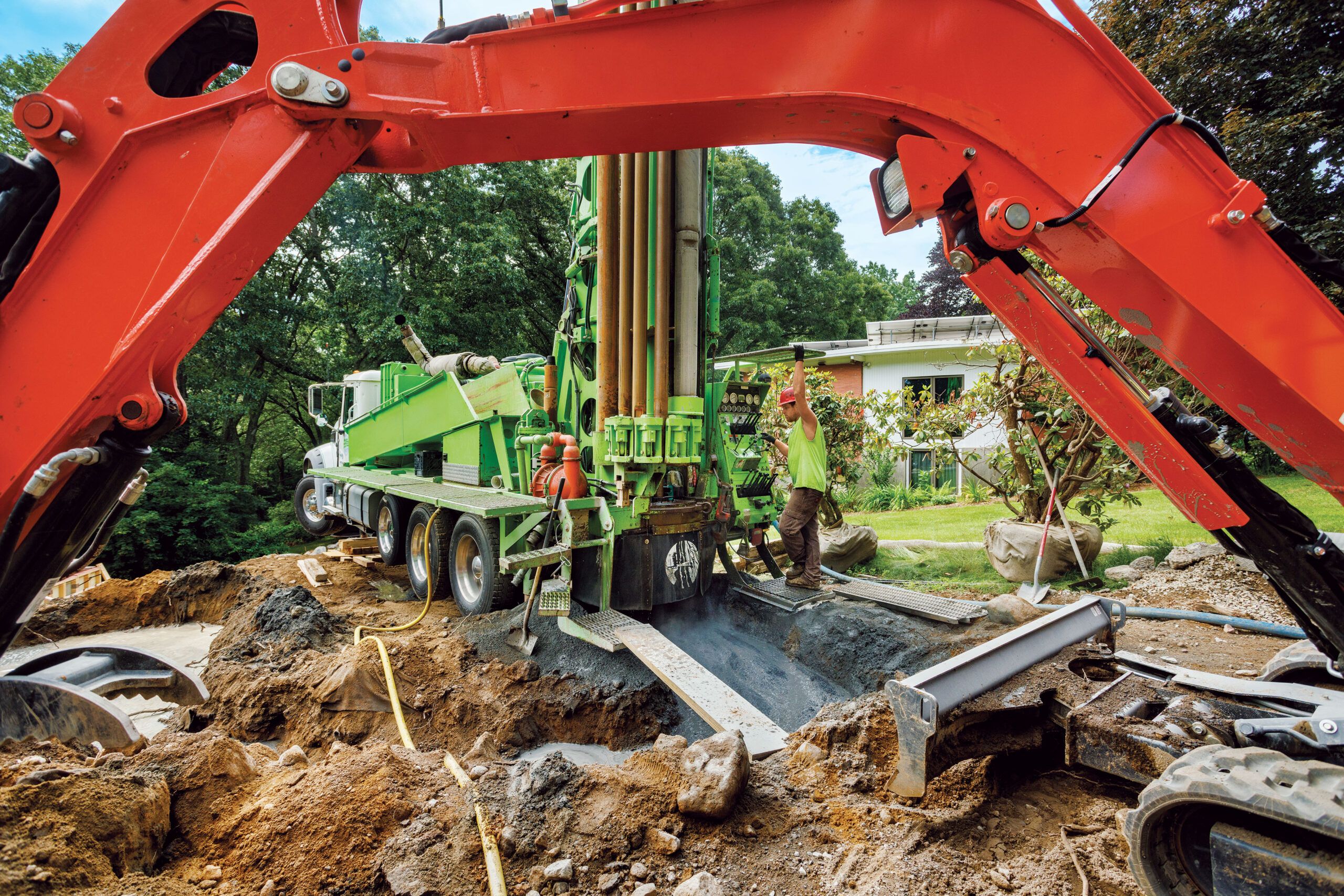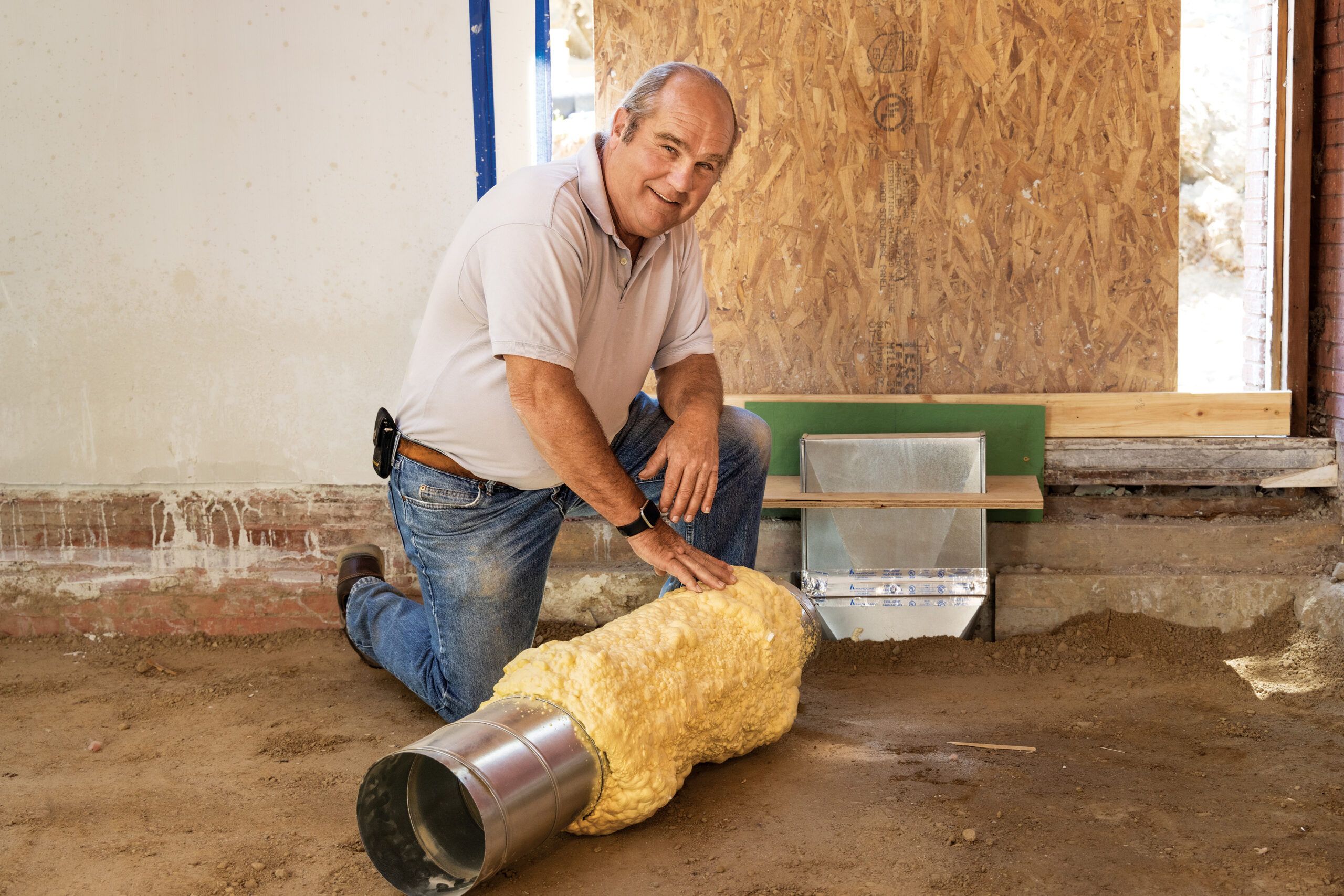The hulking 10-wheel truck rumbled onto the side yard of the TOH TV project house in Lexington, Massachusetts, as TOH home builder Charlie Silva and TOH building engineer Ross Trethewey guided the driver’s path. After a few adjustments forward and back, the crew on board lowered two jacks from the rear and another from the front, lifting the vehicle off its wheels and, using a bull’s-eye bubble level, getting it into a perfectly horizontal position on the sloped terrain.






A drilling derrick pivoted up 36 feet from the truck bed, and soon a slow-spinning carbide bit began chewing into the ground. It took nearly six days to drill the four 500-foot-deep boreholes, or wells, for the house’s geothermal heat pumps, which will provide energy for its heating and air-conditioning.
Geothermal is the greenest climate-control system invented to date. This installation will be paired with ultra efficient radiant floor heat—and its electrical needs powered by a rooftop solar array. All were important choices for homeowners Michelle Werner and Billy Lester. “We know our house won’t change global warming,” says Billy, “but we want to do what we can, and things have ripple effects. Maybe a neighbor or friend will be inspired to do something similar at their house.”
Creating a healthy environment inside their home was equally important to them. Michelle and Billy’s middle child, 13-year-old Caffrey, has Duchenne muscular dystrophy, a progressive muscle-wasting disease affecting his mobility. They chose the mid-century modern house for its mostly single-story footprint, which will accommodate the wheelchair he will someday need, and geothermal combined with radiant floors to produce steady, even temperatures. “He’s sensitive to light and heat, and we want to keep the house at an equilibrium—for Caffrey and for all of us,” says Billy.
Greater efficiency

Heat pumps have a smaller carbon footprint because instead of creating heat through combustion or electrical resistance, they move existing heat from one place to another. That is exactly how air conditioners work—they extract heat out of the indoor air (which creates the coolness you feel), concentrate it so that it’s warmer than the outdoor temperature, and then release it outside. “Heat always moves to cold, so that heat dissipates into the outdoor air,” says TOH plumbing and heating expert Richard Trethewey. Heat pumps are simply air conditioners that work in either direction—in addition to cooling the house, they can gather heat outdoors in the winter (even when it’s frigid), concentrate it, and release it inside.
Most heat pumps are air-to-air systems; they move heat back and forth between the air inside and the air outside. “Air-to-air heat pumps are about three times more efficient than a traditional gas-fired furnace paired with central air,” Richard says. But they can lose their advantage when the temperature really plummets.
“On the very rare 0°F day, they can use as much electricity as electric baseboards.” Geothermal is different. Michelle and Billy’s source for winter heat, and release for summer heat, will be water traveling through those boreholes deep in the bedrock below their yard.
The temperature underground is a steady 50° to 60°F year-round, providing a better release for heat in the summer and a much better supply of heat in the winter. And though the drilling and piping make geothermal expensive—50 to 200 percent more than air-to-air systems, depending on site conditions—Michelle and Billy plan to stay in their house long enough for it to pay for itself, taking advantage of Massachusetts’s rebate program, as well as current federal tax credits that will give them 30 percent of the upfront costs back at tax time.
Superior comfort

The demand, or “load” side—the interior of the house—will be climate controlled by a network of fresh water–filled pipes feeding state-of-the-art HVAC equipment. “Water is a more efficient medium for transporting temperature energy than the refrigerants used for air-conditioning,” says Ross.
Plus, using water means the geothermal system can deliver radiant floor heat and domestic hot water, too. The geothermal heat pumps will switch back and forth between heating and cooling as needed, always maintaining a tank of cold water that’s ready to feed the air handlers throughout the house when the system calls for cooling and a hot tank that will feed those same air handlers for heating season. The hot tank will also serve as a preheater for a domestic hot-water tank with its own integral heat pump on top.
“We don’t actually need the heat-pump tank to get the water up to temperature,” says Richard. “We’re using it to squeeze every ounce of energy out of the ambient heat in the mechanical room—and to dehumidify the space.” And the hot tank will feed a mixing valve that delivers 90°F water to the radiant flooring system, which is ideal for an open-floor-plan house like this one. “Being near something warm makes you feel warm,” says Richard. “When the floor is around skin temperature, you feel cozy, without drafts, hot spots, or heat loss out the window.”
Four radiant zones and five air-handler zones will allow family members to adjust different areas, including bedroom suites, to their personal preferences. And the system will automatically reduce climate control in spaces that are not being used—and will accommodate even drastically different demand around the house: On a sunny winter day, for example, the system will be able to cool spaces in front of the large windows on the southern exposure while heating the rest of the house.
Serious payback
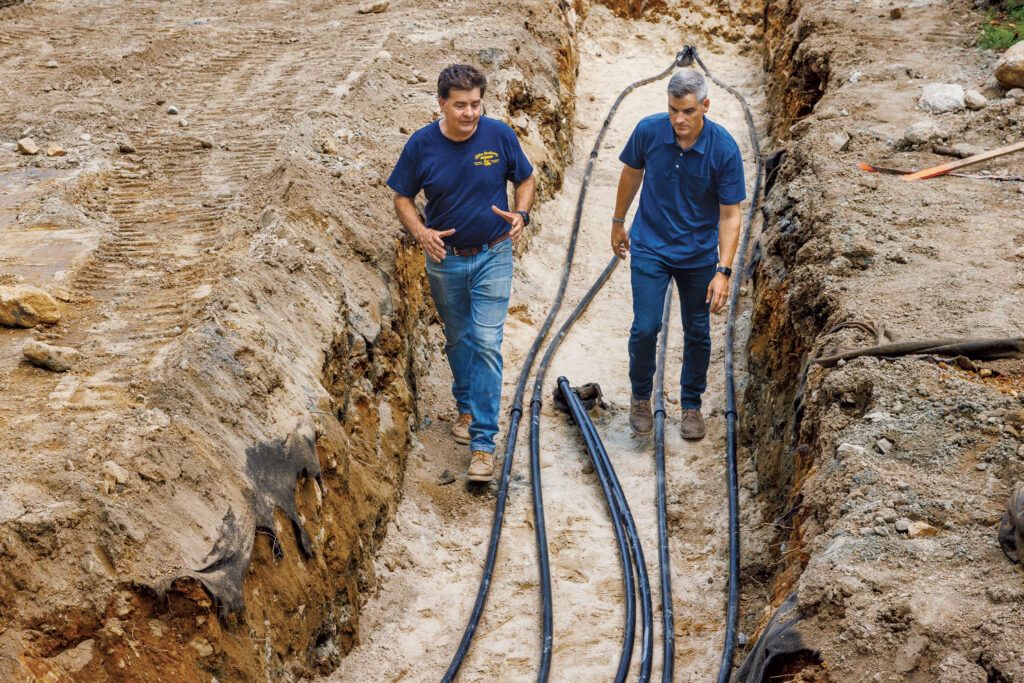
A geothermal system can pay for itself in 10 to 15 years through savings on utility bills—and the environmental benefits go beyond efficiency. Using electricity powered by solar to power heat pumps is far cleaner than burning fossil fuels at home. Thanks to its single-story layout, Michelle and Billy’s house has sunny roof space for 68 solar panels, plenty to power the geothermal system, though possibly not 100 percent of the household’s needs or their electric vehicles. It’s hard to know exactly what their usage will be until they start living with all the new systems and the extensive insulation being added to the house. More panels would have required cutting down trees, a trade-off the couple was not willing to make.“We really like how the systems play off of each other,” Billy says. “Geothermal is great on its own. It’s even better with radiant heat. And even better when powered by the sun that hits our roof.”
How a Geothermal HVAC System Works
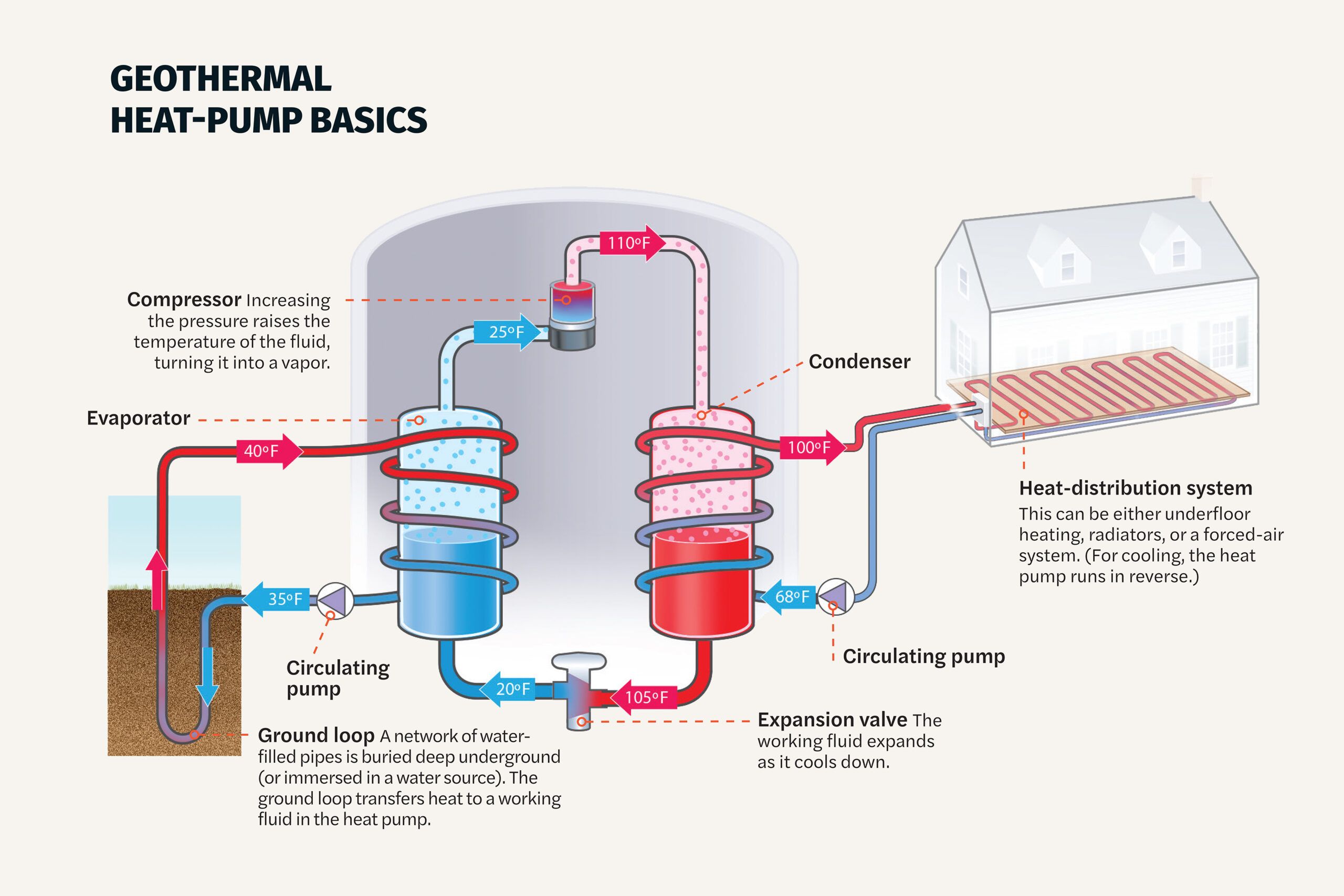
Billy and Michelle’s HVAC is known as a water-to-water system—closed loops of water will travel down into the ground to absorb heat in the winter and to disperse it in the summer. A separate network of water pipes will supply the house’s radiant heat, air handlers, and domestic hot-water supply. Here’s a look at the components:
Four closed loops
Each borehole holds a U-shaped loop of 1¼-inch high- density polyethylene tubing filled with a mix of 82 percent water and 18 percent propylene glycol, a nontoxic antifreeze, which circulates to two geothermal heat pumps in the house and back out again.
Geothermal heat pumps
These compress the geothermal water mix to concentrate the heat so it can be transferred into the house in winter—and dissipated into the ground in summer. They will also transfer hot and cold energy to a separate fresh supply of water that gets delivered to equipment around the inside of the house.
Hot tank
The heat pumps will keep this tank filled with 115°F water that the radiant floors and air handlers can call on as needed. The tank will also serve as a preheater for domestic hot water. Fresh water will run through a coil inside the hot tank, absorbing heat like a hydro-powered instant water heater.
Cold tank
The heat pumps will keep the water in this tank at 45°F to supply the air handlers when the system calls for cooling.
Heat-pump water heater
This unit will add more heat to the preheated domestic hot water, maximizing efficiency by using ambient heat from the mechanical room, dehumidifying the area in the process.
In-floor radiant heat
A mixing valve will add cold water to the hot-water supply to bring it to 90°F before it snakes back and forth under the house’s floors.
Air handlers
Separate coils for hot and cold water will allow the air handlers to switch from heating to cooling depending on what the controls are calling for.
Controls
Smart tech will allow the system to deliver different amounts of heating and cooling to zones with different sun exposures, activity levels, and thermostat settings.
Four types of geothermal
The best layout for a geothermal system’s piping depends on the size of the property and its proximity to a body of water.
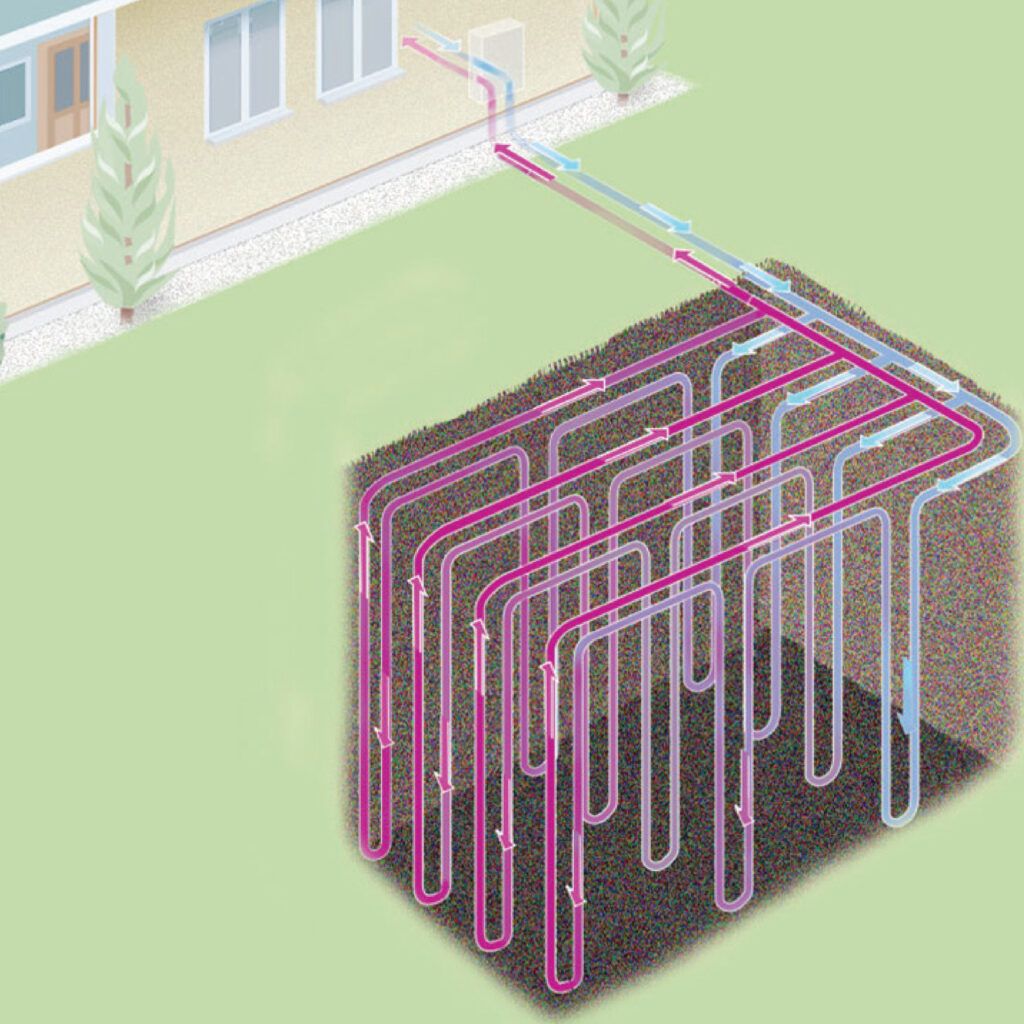
Vertical closed loop: Vertical wells, as in Michelle and Billy’s system, require the least amount of land—though they still take up some space, since the boreholes must be 20 feet apart—and result in the least disruption of the landscape. | Illustration by Ian Worpole
Horizontal closed loop: On large lots—especially with new construction— horizontal piping is more cost-efficient since no drilling is required. Instead, a backhoe digs trenches from 4 to 10 feet deep, and pipes are laid 2 feet apart—or coiled, which allows for a shorter trench. | Illustration by Ian Worpole
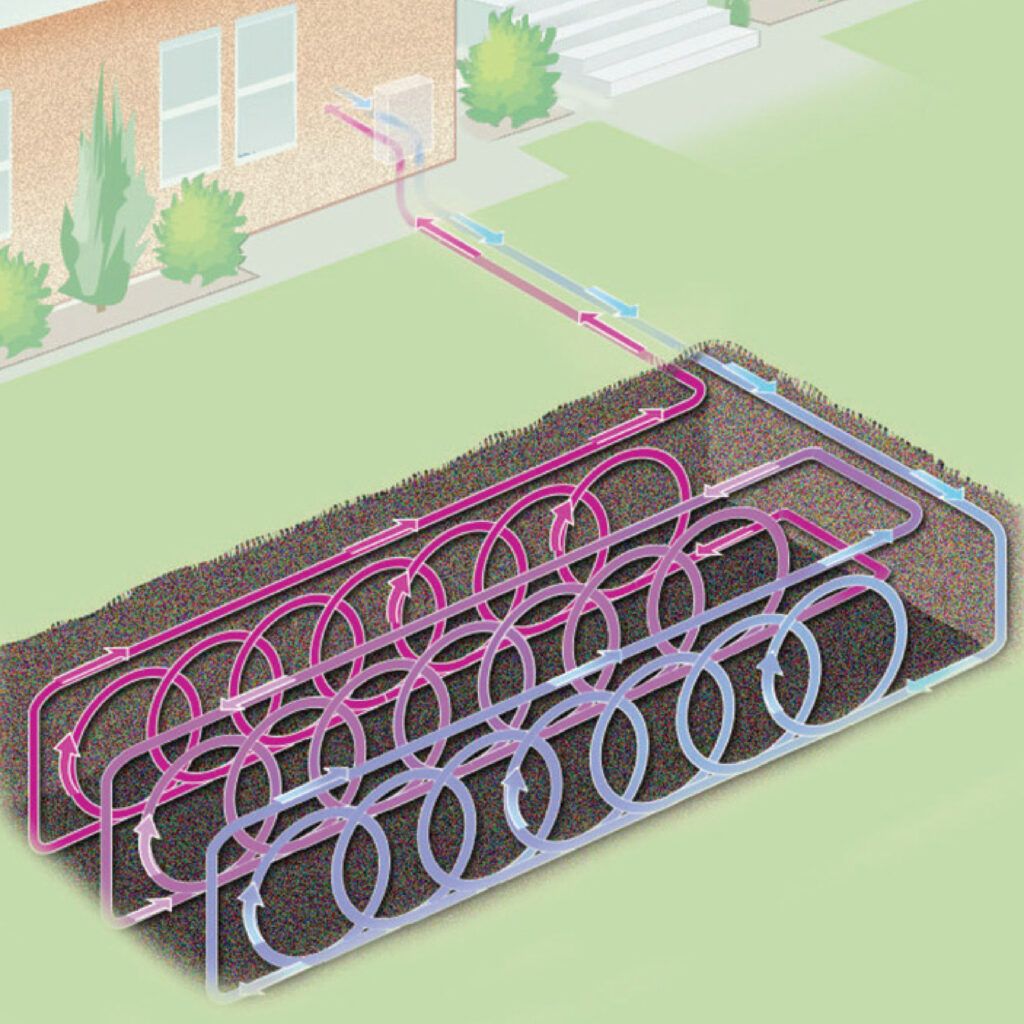
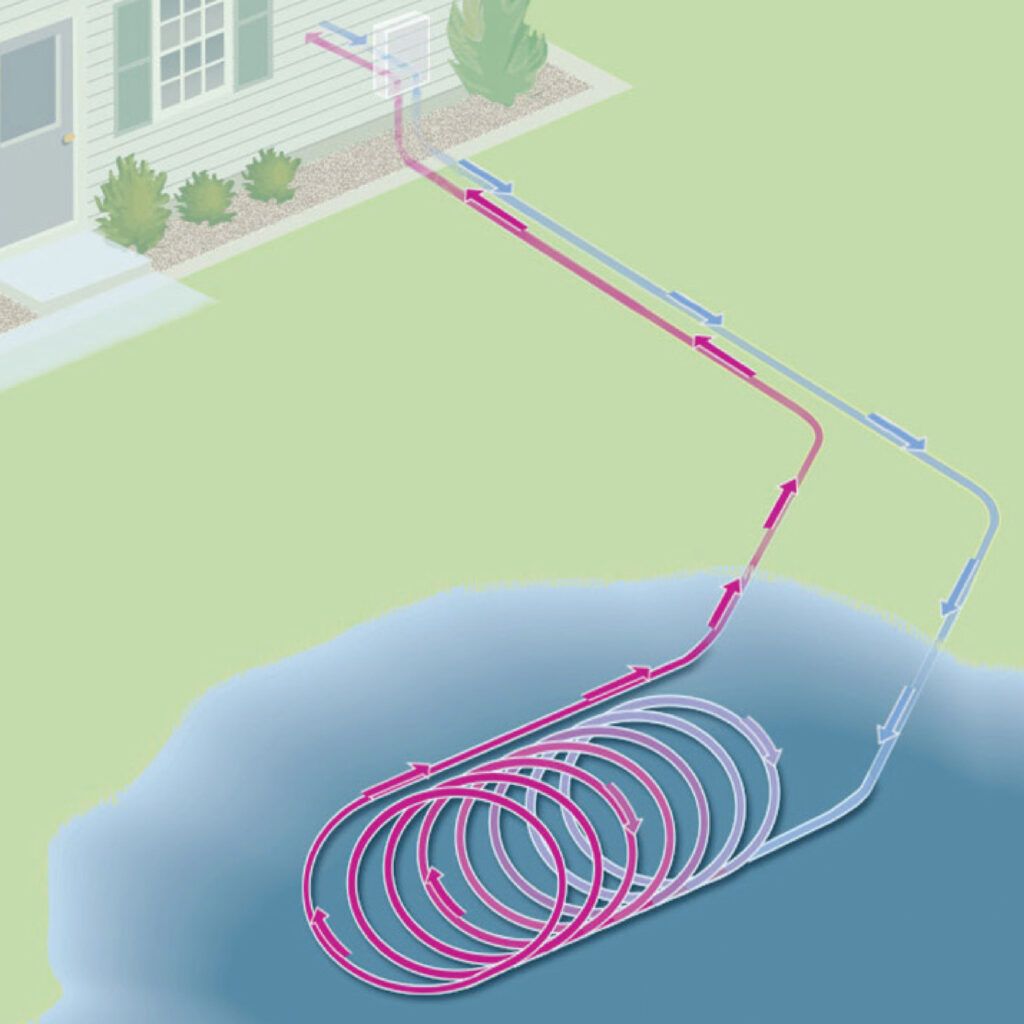
Pond/lake closed loop: If there is a body of water of sufficient size adjacent to the house and available for its use, it may also be possible to lay a closed loop of piping on its bottom—at least 8 feet down—to use the pond or lake as the source and discharge spot for the heat. | Illustration by Ian Worpole
Open loop: This type of system may use an irrigation well to supply water for the heat pump. The water is drawn in, circulates through the heat pump, and then is released back outside. This requires a reliable supply of clean water—and is subject to local codes about groundwater discharge.| Illustration by Ian Worpole
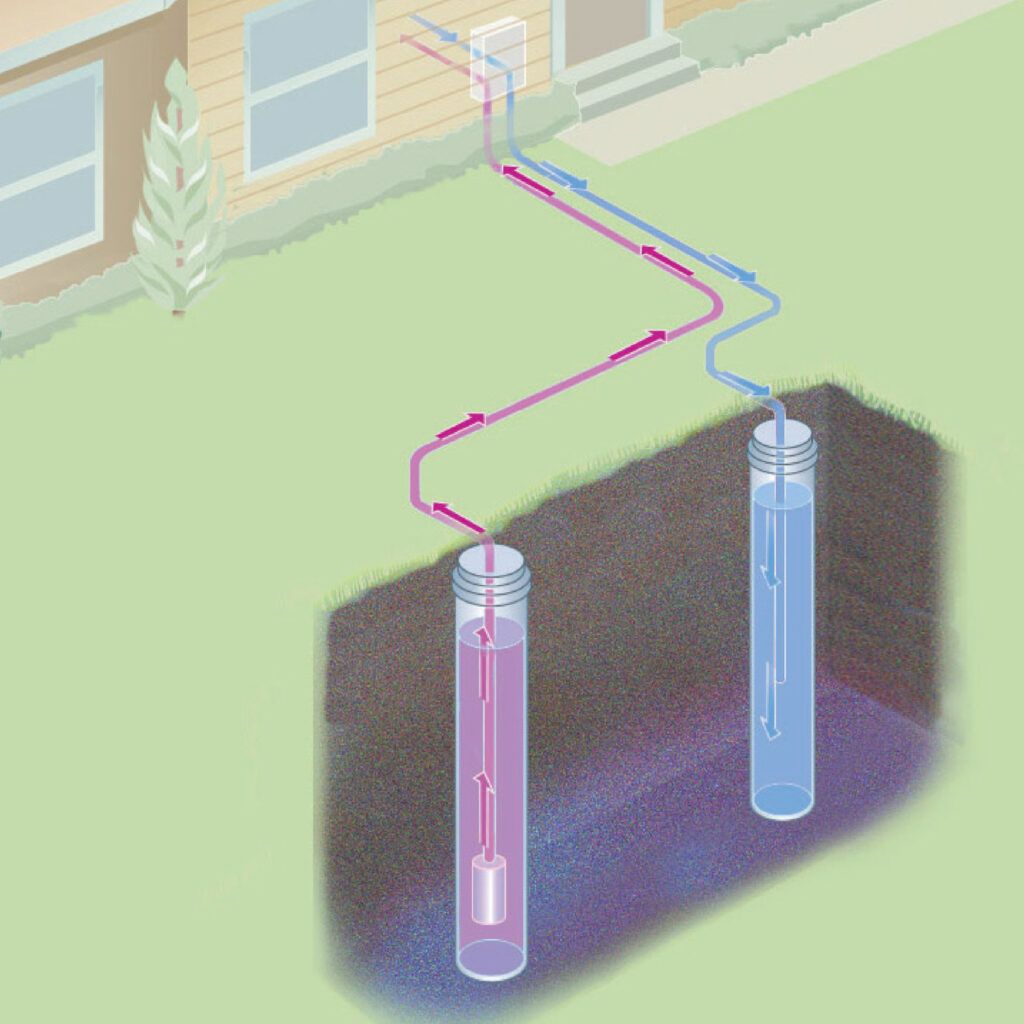
Making Geothermal More Accessible
Early geothermal systems were first installed in the United States in the 1940s. “The concept was great, but the ground loops didn’t work well with the piping materials available at the time,” says Jack DiEnna, a 35-year industry veteran who serves on the board of the International Ground Source Heat Pump Association. “Onc high-density polyethylene came on the scene in the 1970s, geothermal suddenly became viable in the real world.”

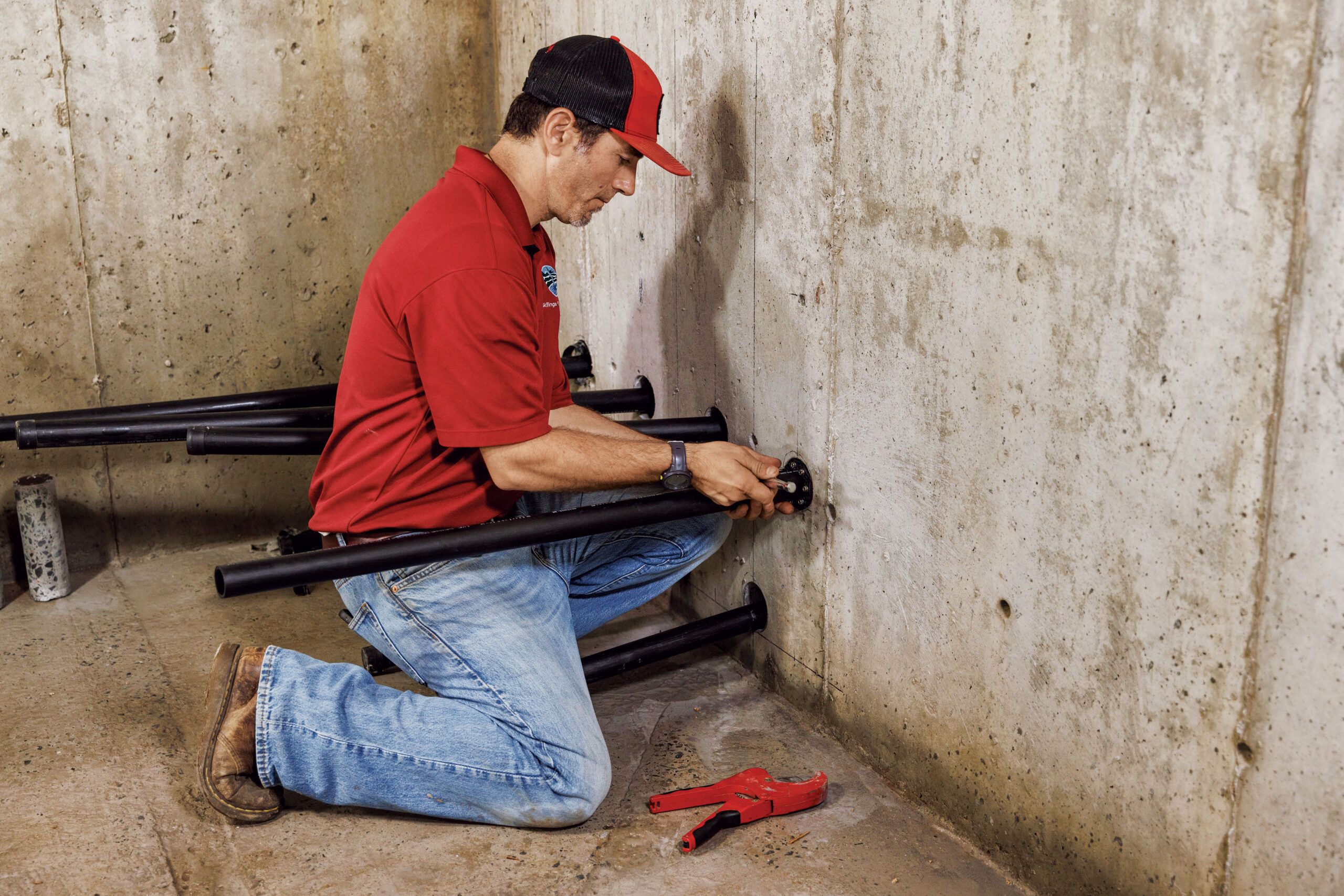
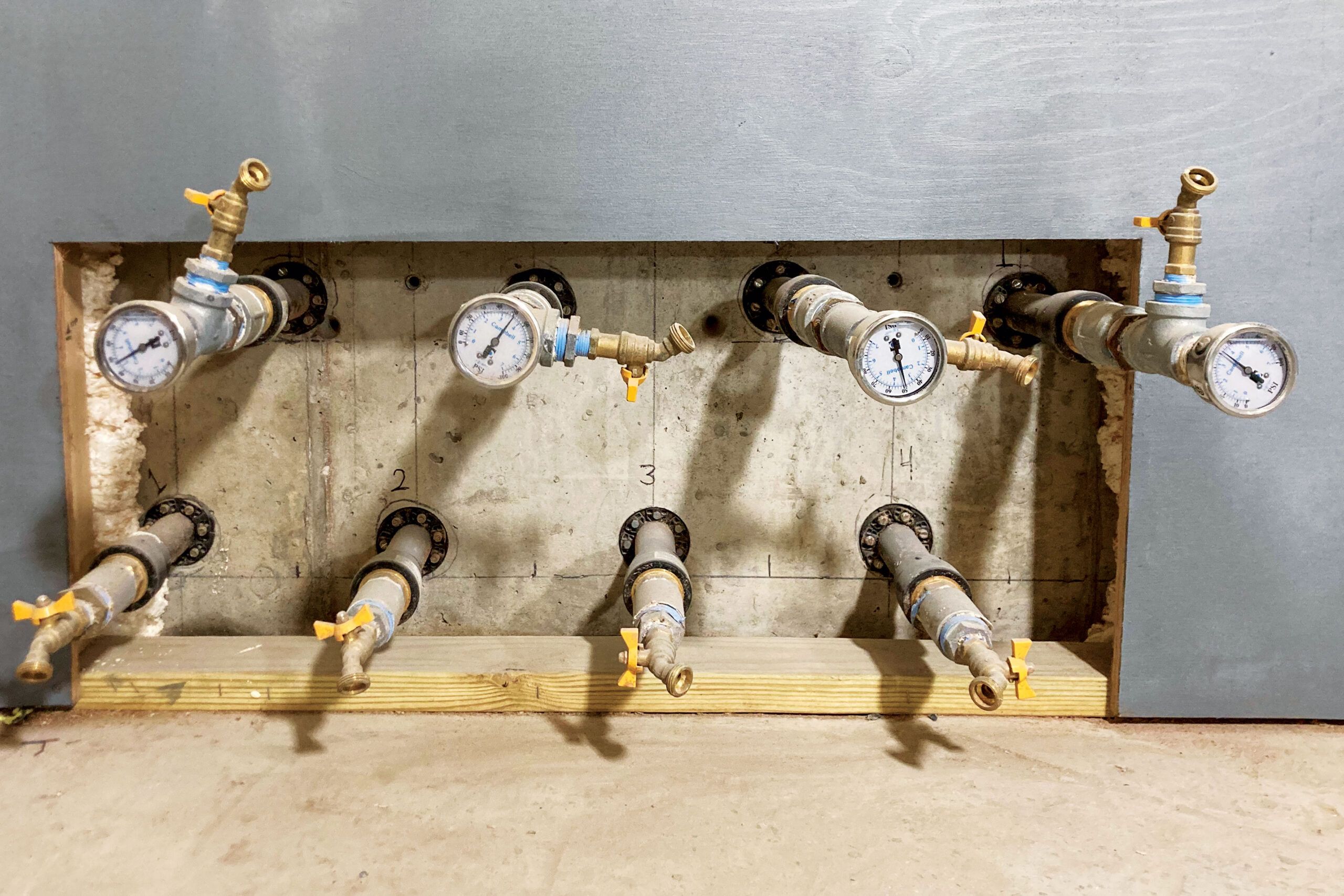



Still, geothermal remained exceedingly rare until it first became eligible for federal tax credits and other incentives in 2008. The benefits were extended in 2022 to 30 percent of the entire installation cost with no cap, through 2032.
Today about 70,000 residential geothermal projects are installed in the United States annually, DiEnna say—just 2 percent of the overall market. “Still, it was only 1 percent five years ago, and we’re expecting 10 times that growth over the next few years,” he adds. One reason is that industry leader Dandelion Energy is pioneering ways to lower homeowners’ costs, such as speedier sonic drilling that vibrates 9,000 times a minute, essentially liquefying rock; casing that comes back out of the hole after grouting and gets reused; and zero-upfront-cost financing, much like what’s available for solar.
“We’re also starting to see developers put in geothermal systems for entire housing complexes and utilities putting loops under school fields and connecting them to the surrounding neighborhoods,” says DiEnna. Usually, in both cases, customers simply pay the developer or utility a monthly usage fee. These types of municipal and multi-unit installations are driving the huge anticipated growth of geothermal. “Retrofits used to account for about 65 percent of installs, and they aren’t decreasing,” DiEnna adds. “But the growth of shared systems has already dropped that number to 50 percent—and falling.”
